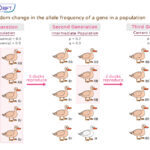Central Dogma
The central dogma is a theory that states how genetic information flows from DNA to RNA to protein. Here, the genetic codes of DNA are first transferred to RNA, which are then read to give off the final product, the protein.
A basic flow chart of this statement would be:
DNA → RNA → Protein
Processes Involved in Central Dogma
As stated, the central dogma involves two major processes for the expression of genetic information from DNA to RNA to protein.
1. Transcription (DNA → RNA)
Here, the genetic information gets transferred from double-stranded DNA to the single-stranded RNA molecule. This step takes place in the cell nucleus and is mainly mediated by the enzyme RNA Polymerase. The newly formed RNA undergoes post-transcriptional modifications and enters the next step once matured.
2. Translation (RNA → Protein)
Once the mature RNA leaves the nucleus, it codes for specific amino acids in the ribosome to synthesize proteins. Being an active process, it requires energy provided by the charged tRNA molecules.
Note: As stated, genetic information flows from DNA to RNA to protein through these two primary steps. However, DNA continues to make its own copy by replication. On the other hand, in some viruses, DNA is formed from RNA by reverse transcription process.
Why is it Important
DNA being the master molecule, contains instructions for making a protein, which are copied by RNA. So, central dogma provides the basic framework for the whole process.
-
References
Article was last reviewed on Friday, February 17, 2023





